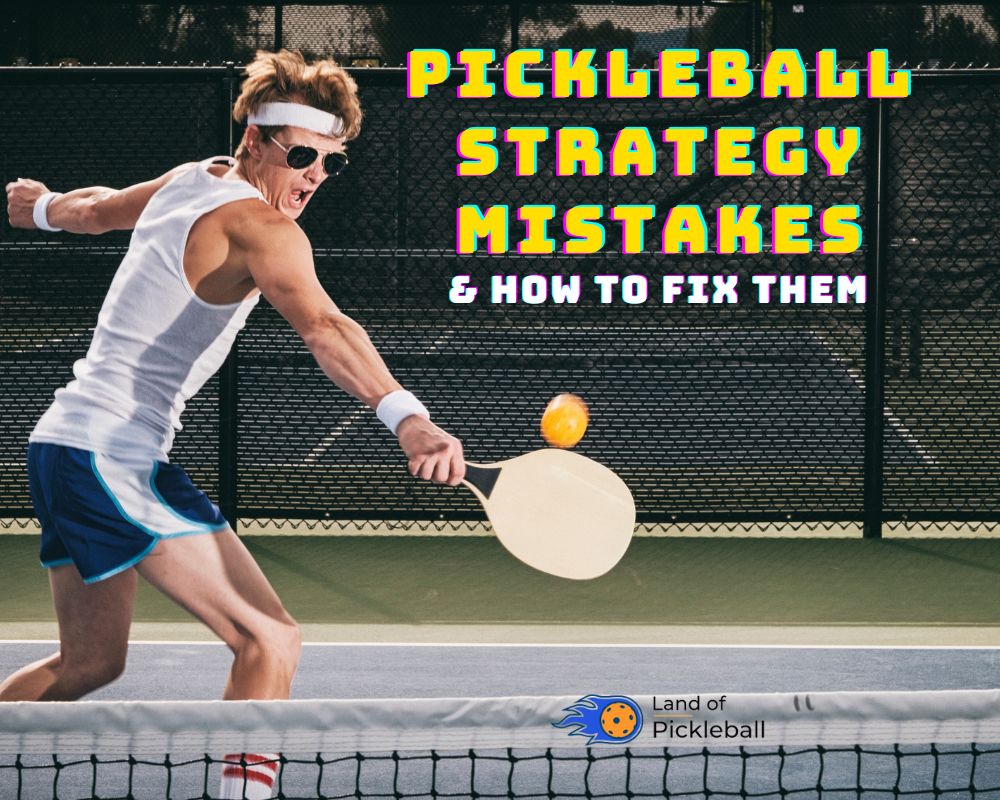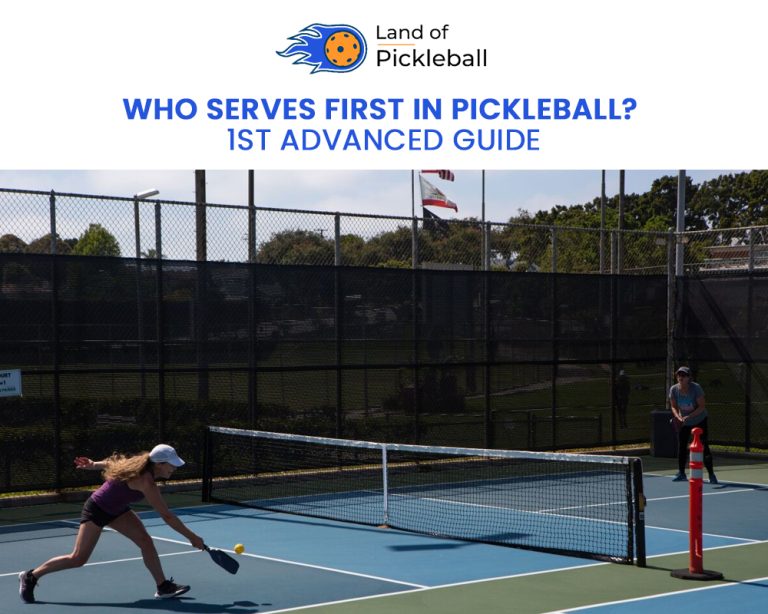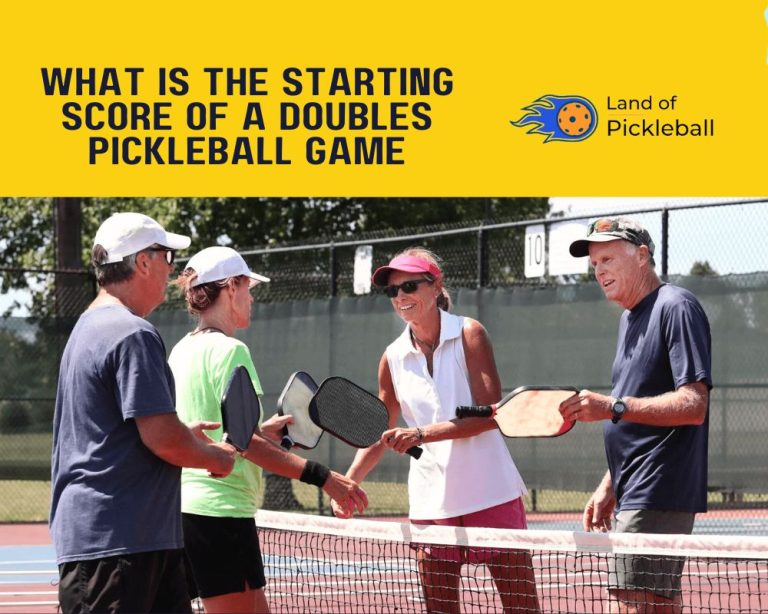11 Top Pickleball STRATEGY Mistakes & How to Fix them?
Fix top pickleball strategy mistakes for better gameplay. Let’s focus on shot selection & power, serving tactics, footwork, and other Pickleball drills.
Identifying the general Pickleball strategic mistakes is vital for players aiming to grow from their initial level to pro playing stages. While these mistakes may persist at higher levels, addressing them is essential for continued improvement. We provide the actual strategic blunders, why these errors happened, and how you can improve these errors.
Therefore, your progress in the Pickleball court is usually associated with your strategic improvements, skills, and further playing tactics. You may master your playing fundamentals and obtain the full potential on your own today’s mini Pickleball court or perform best in professional tournaments. So, without wasting your time, you’re capable of learning about these pickleball strategy mistakes.
Major Pickleball Strategy Mistakes
LOP covers 11 major Pickleball Strategy Mistakes, which are:
Mistake #1: “Wandering” Server
This phenomenon occurs when a player unconsciously moves forward after serving the ball. This forward drift lacks any strategic purpose and simply involves taking a few steps toward the net.
This mistake poses a serious concern when the opponent team executes the returning deep shot toward the baseline. It may make the third shot more difficult for the serving player. Thus, moving forward after serving increases the risk of receiving a return shot at one’s feet, forcing the player to hit while backing up, which is not an ideal scenario.
So, instead of advancing into the court after serving, it is reliable to remain behind the baseline. This approach enables better readiness for returning a deep shot near the baseline and makes it challenging for the opponent team. Meanwhile, by staying back, you can maintain forward momentum for their subsequent shots.
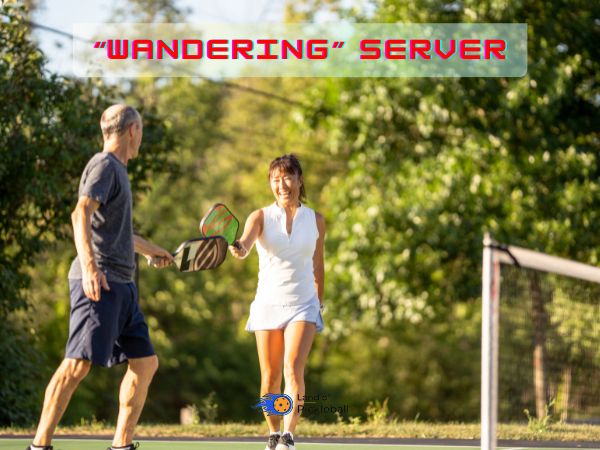
Why it’s a Mistake?
Your forward movement after serving leaves other players vulnerable to deep returns aimed at your feet. Your opponents can exploit this by driving the ball on their third shot. This step may put you (the serving player) in a disadvantaged position to return effectively.
How to Fix It?
You must practice one or two steppings backward after serving to create distance. This time may give an edge for readiness for handling varying return shots, whether short or deep. This adjustment provides better recovery options and improves overall court positioning.
Mistake #2: Ready for the Serve Close to the Baseline
If you stand at the forefront of the baseline while awaiting a serve, it can be a significant error. So, it’s another common error that occurs being positioned directly on the baseline during the return.
This error becomes problematic when facing skilled opponents who hit closer to the baseline at an increasing pace. This short makes it challenging to respond effectively. Staying at the baseline forces players into difficult half-volley shots or backward movement to create space. That’s why your momentum goes backward to NVZ.
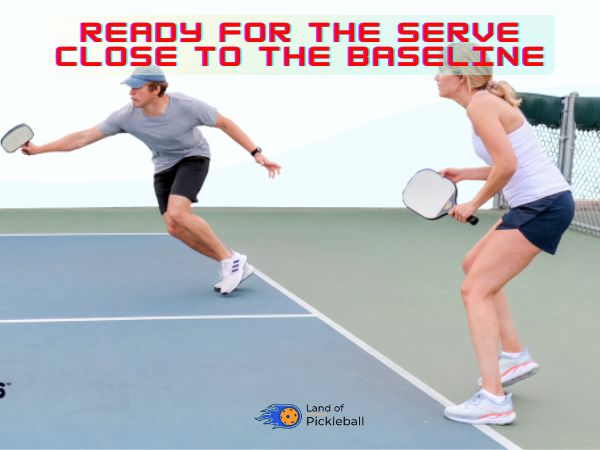
Why It’s a Mistake?
You must stand directly on the baseline, which leaves no room for movement if opponents serve deep and at the feet. It makes this short harder to move forward, which is typically easier in sports than moving backward.
How to Fix It?
To improve this mistake, you must stay two to five feet behind the baseline. This depends on the serve’s speed and depth while awaiting the opponent’s serve. Staying back allows for more time and space, making it easier to return deep serves and increasing the forward momentum towards the net. So, it ensures your readiness to respond quickly, even to short serves and rallies.
Read More: What is a Rally in Pickleball?
Mistake #3: Dead Dinks Hit
Well, dinking involves hitting the ball delicately over the net, just within the NVZ. A dead dink occurs when the shot lacks spin or variety in placement, making it predictable and easy to attack. It’s because this dink without varying placement or spin can lead to your opponent easily pressing with aggressive shots or smashing back at you if the ball pops up.
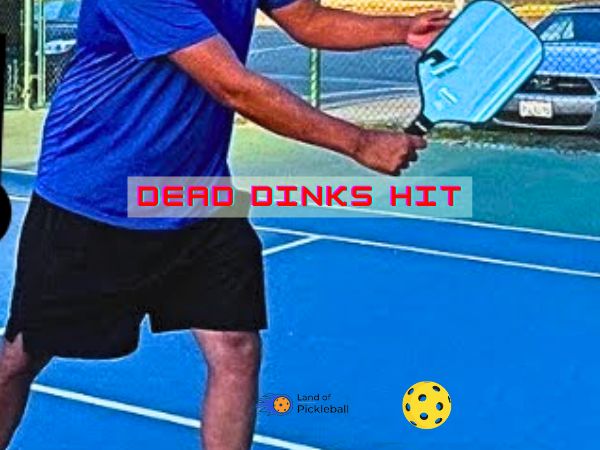
Why It’s a Mistake?
Your consistent high shots with little spin and hitting the same spot allow opponents to respond aggressively. It allows them to maintain a strong position throughout your game.
How to Fix It?
You need to vary your placement by targeting your opponent’s forehand or backhand and aiming at their feet. However, mix up your dinking by moving the ball around, varying spin, power, and direction. Your blend of dinks may keep your opponent guessing and prevent them from settling into a comfortable rhythm.
Mistake #4: Ease in the Push off NVZ line
Sometimes, when you’re positioned at the NVZ line, you may notice yourself gradually being pushed back toward the baseline after each shot. This backward movement can lead to being too far back to respond to short shots or dinks effectively. It happens due to a lack of awareness or failure to hold your position firmly.
If pushed or drifting away from the NVZ line, players must promptly return to the line before their opponent plays the shot to limit the opponent’s attacking options at their feet. Furthermore, converting your deeper dinks into dink volleys can help maintain a position at the NVZ line.
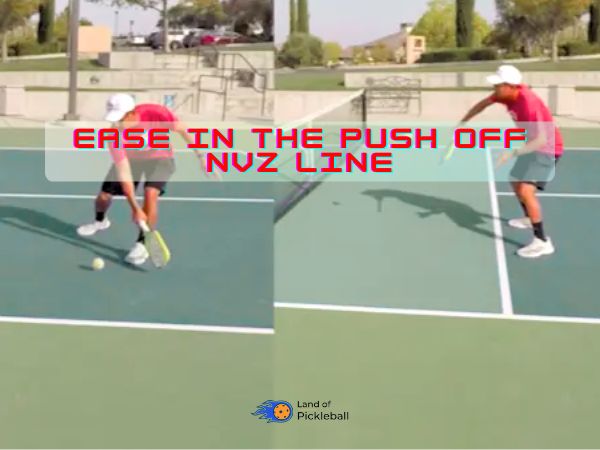
Why It’s Detrimental?
It allows you to be pushed back and puts you in a bad position, forcing you into a defensive stance.
How to Correct It?
To prevent and maintain it in your court, you must be aware and focus on the NVZ line. Step forward and adopt an offensive stance at the net. If you start drifting backward, consciously step forward and aim to volley the ball rather than letting it bounce. Additionally, intercept deeper dinks with volleys to hold your position.
Mistake #5: “Win from the Back”
In pickleball, most points are scored at the net, not the baseline. So staying back, known as “winning from the back,” is a common mistake among players. Many players prefer the safety of the baseline, but dominating the net is key to winning. You must gain an advantage, prioritize advancing to the net, and perfect your third shot drop. Therefore, getting up to the net is essential for success.
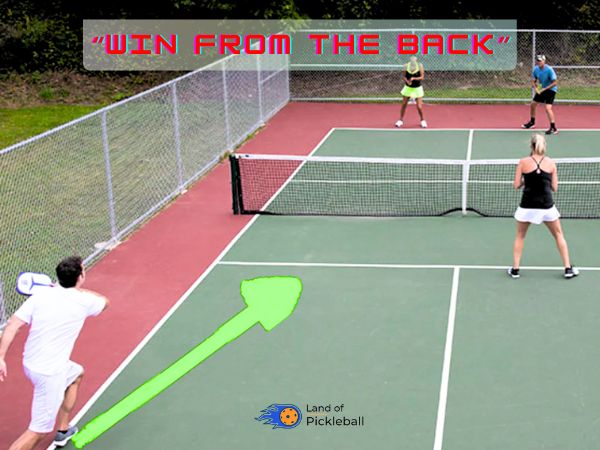
Why It’s Detrimental?
Staying at the baseline and attempting to “win from the back” puts you at a disadvantage. Teams that control the net usually win. Your back-staying position allows opponents to exploit angles and execute soft shots, making it difficult to defend effectively.
How to Correct It?
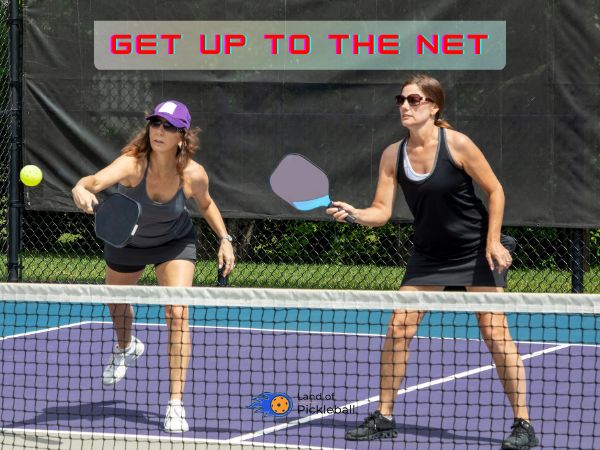
You must take an aggressive approach by consistently moving towards the net. To do so, focus on improving your third shot drop and transitioning smoothly to the NVZ line. Meanwhile, you may develop a proactive mindset of “getting up to the net” to gain an advantage. Your continuous work on advancing your position and practice transitions will enhance your comfort level.
Mistake #6: Drive and Rush
Players often rush forward immediately after hitting a shot, known as the “Drive and rush” tactic.
Why It’s Detrimental?
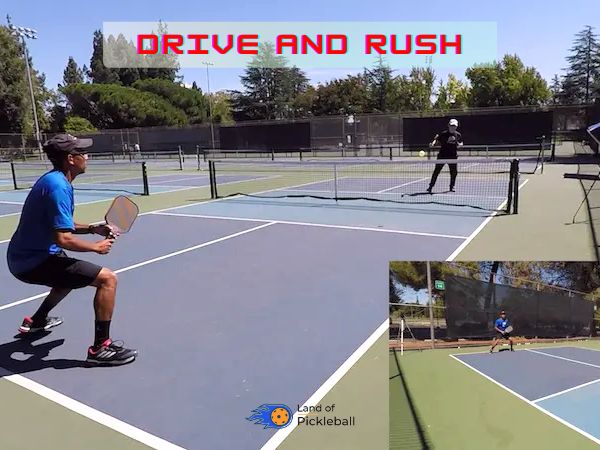
Rushing forward after hitting a drive can leave you vulnerable to counterattacks from your opponent team. However, it’s important to assess the quality of your shot (drive) and know about your opponent’s response instead of unthinkingly charging forward.
How to Correct It?
Instead of blindly rushing forward, adopt a “Drive and assess” approach. You must take time to evaluate each shot and strategize your forward movement, which can help you stay in control of the point. You are capable of ensuring your readiness for whatever comes next.
Mistake #7: Prevent your Backhand Shots
During a pickleball match, it’s expected that balls will come to your weaker side. It often prompts the need to move around them to utilize your stronger forehand. However, consistently avoiding your backhand can lead to being caught out of position. It also hinders your ability to recover effectively.
Why It’s a Detrimental?
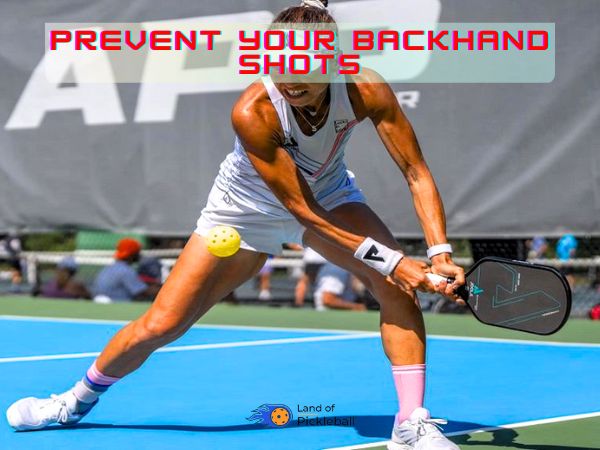
If you neglect your backhand, it limits your versatility on the court. Firstly, your constant move for a forehand shot can disrupt your positioning, especially in significant moments near the net. Secondly, by neglecting your backhand, you miss out on the opportunity to improve and develop this essential aspect of your game.
How to Fix It?
You must challenge your hesitancy to use your backhand. While it may be challenging at first, but doing your backhand and incorporating it into your gameplay is essential for overall improvement. Though, you may practice Pickleball drills specifically targeting your backhand to build confidence and proficiency over time. While practicing your drill, you must master your backhand, which opens up new dimensions to your game, enhancing your performance significantly.
Mistake #8: Being a Spectator in Today’s Pickleball Court
It’s vital to stay engaged and proactive throughout your Pickleball game. Some players fall into the trap of simply watching the action instead of actively participating. This passive approach can significantly hinder your performance and leave you out of position.
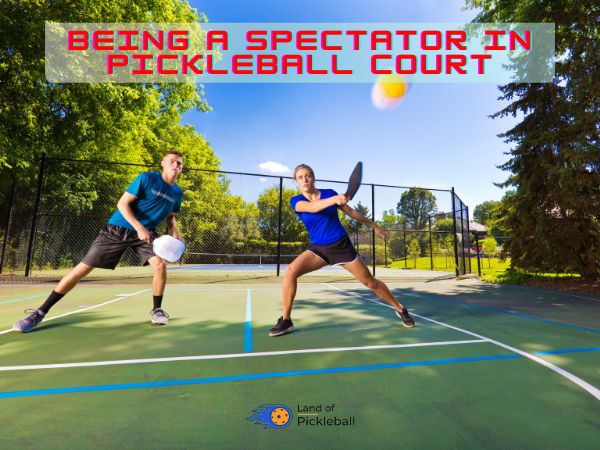
Why It’s a Mistake?
Remaining static after hitting the ball leaves you defenseless to your opponent’s next move. Without anticipating their shot and adjusting your position accordingly, you’re more likely to be caught off guard and unable to make a successful return.
How to Fix this Mistake?
After making your shot, immediately transition back into a strategic position on the court. Focus on where your opponent may hit the upcoming back and position yourself accordingly. Hence, by staying proactive and maintaining good court coverage alongside your partner, you’ll be better prepared to respond to your opponent’s moves and make effective returns. Don’t wait until contact is made; act decisively to maintain control of the game.
Mistake #9: Play with Small (Marginal) Shots
In pickleball, your playing precision is a significant element, but aiming too close to the lines can lead to frequent errors. It’s usually observed in players who hit with a margin that is too small. This may consistently aim hazardously close to the sidelines or baseline.
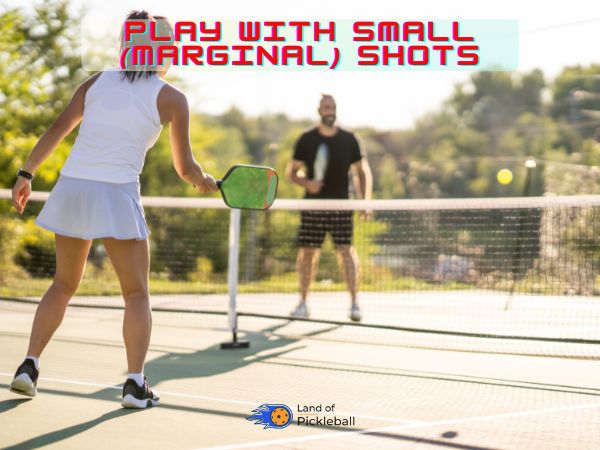
Why It’s a Detrimental?
While your game’s perfection is essential in certain situations, excessively tight targeting increases the risk of errors. Your focus clearly on hitting near the lines neglects the sufficient room available on the court. It results in unnecessary unforced errors that can significantly impact match outcomes.
How to Fix It?
To lessen this mistake, you should prioritize expanding your margin for error. Rather than aiming for the lines, aim for a target area at least two feet inside them. This approach provides a buffer zone that permits minor imprecisions in your shots without compromising your shots’ effectiveness. Hence, as you refine your skills, you need to maintain a larger margin for error, which will contribute to more consistent and successful gameplay.
Mistake #10: Play too Conservatively
In pickleball, regardless of skill level, excessively conservative play can obstruct your performance and lead to missed opportunities. So, going with a more aggressive approach is essential in this fast-paced game. It allows you to dominate the entire potential of your gameplay.
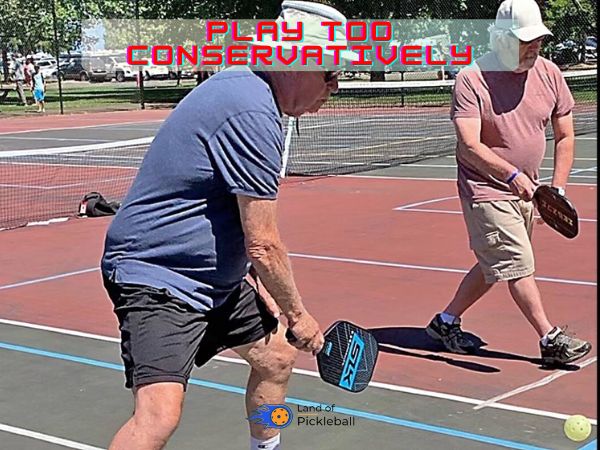
Why It’s a Mistake?
If you play too conservatively, you limit your ability to seize control of the game and capitalize on favorable situations. By constantly playing it safe, you risk falling behind. Meanwhile, you allow your opponent to dictate the pace of play, ultimately increasing errors and potential game losses.
How to Fix It?
You must keep a more assertive mindset on the court. Don’t shy away from taking calculated risks and seizing opportunities to assert dominance. By adopting a more aggressive playing style, you’ll not only surprise yourself with newfound power but also elevate your game to new heights.
Mistake #11: Ignoring Communication with Your Partner Player
In doubles pickleball, effective communication between partners is vital for success. Your failure to communicate can result in misunderstandings, missed opportunities, and ultimately lost points. You must establish clear Pickleball doubles strategies and communication protocols to ensure that both partners are aligned. They may become each other’s strengths in court.
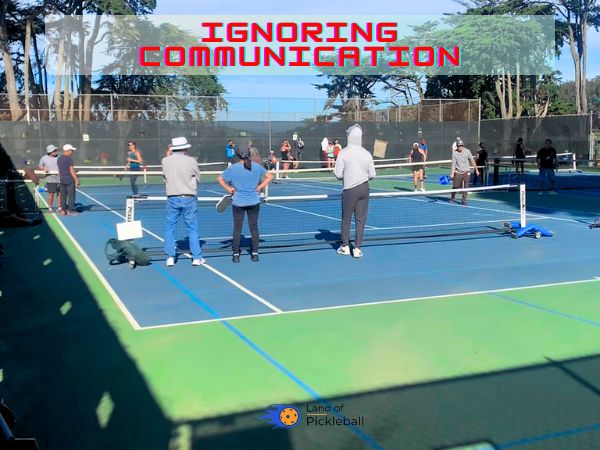
Why It’s a Mistake?
Lack of communication causes confusion and assumptions in the court. It may lead to missing shots and lost points. Even experienced partners can fall victim to miscommunication if they neglect to maintain open dialogue and establish clear signals and calls.
How to Fix It?
You need to prioritize communication with your partner. You both discuss strategies, establish signals, and maintain an ongoing dialogue throughout the match. So, by making clear communication, you and your partner can navigate the court effectively and maximize your chances of success.
Final Thoughts
There are top Pickleball Strategy mistakes that the majority of players make during their court time, even in professional matches. To improve your doubles and singles Pickleball strategy mistakes, you should learn to maintain your position on the court, know your better reaction time, and vary your shot selection. These mistakes can be overcome by correcting your techniques and working on your pickleball skills as well. Additionally, avoiding big backswings and opting for controlled shots over excessive power can enhance overall gameplay.

